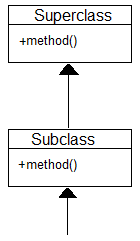CSC/ECE 517 Fall 2010/ch7 7f PW: Difference between revisions
Jump to navigation
Jump to search
No edit summary |
No edit summary |
||
| Line 2: | Line 2: | ||
==What is the Call Super Anti-pattern== | ==What is the Call Super Anti-pattern== | ||
The Call Super [http://en.wikipedia.org/wiki/Anti-pattern anti-pattern] shows up occasionally in object oriented code. Any time an inherited class overrides a method but is still required to call super() at some point during the method, then that is a case of this anti-pattern. It is not a good idea to require something else being called at some point during the method. | The Call Super [http://en.wikipedia.org/wiki/Anti-pattern anti-pattern] shows up occasionally in object oriented code. Any time an inherited class overrides a method but is still required to call super() at some point during the method, then that is a case of this anti-pattern. It is not a good idea to require something else being called at some point during the method. | ||
[[Image:Callsuper.png|Call Super Anti-pattern]] | |||
===Examples=== | ===Examples=== | ||
Revision as of 00:44, 30 November 2010
The Call Super Anti-pattern
What is the Call Super Anti-pattern
The Call Super anti-pattern shows up occasionally in object oriented code. Any time an inherited class overrides a method but is still required to call super() at some point during the method, then that is a case of this anti-pattern. It is not a good idea to require something else being called at some point during the method.

Examples
public class TestCase
public void setup() {
doStuff();
}
public class TestCaseOne extends TestCase
public void handle() {
super.setup();
setupForTCOne();
}
References
[1] Wikipedia, the free encyclopedia: Call Super, 2010. Wikimedia Foundation, Inc.: [1]
[2] MF Bliki: Call Super[2]